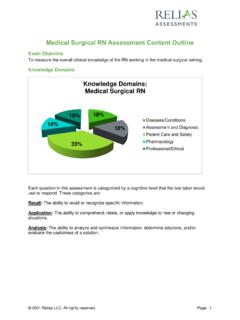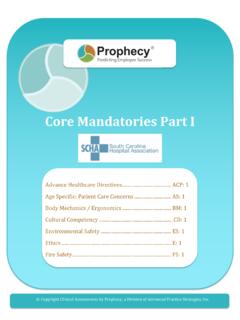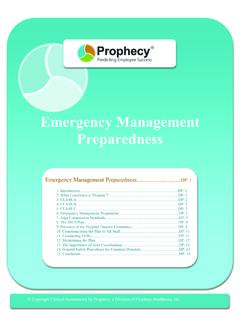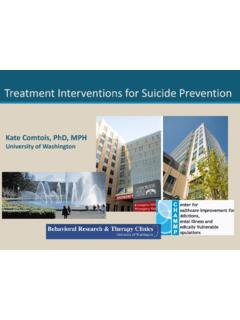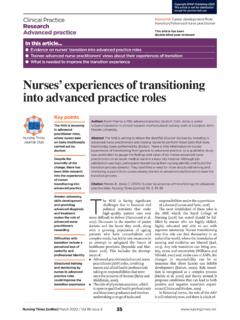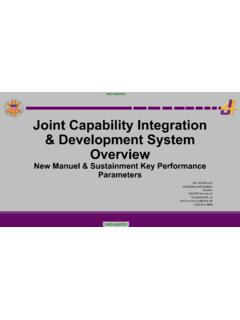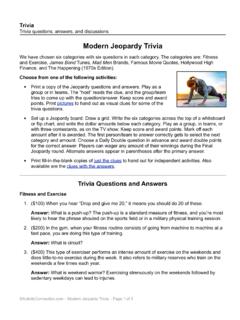Transcription of © Copyright Clinical Assessments by Prophecy, a Division ...
1 Copyright Clinical Assessments by Prophecy, a Division of Advanced Practice Strategies FI: 1 Foundations of ECG Interpretation INTRODUCTION The heart is central to the success of all body systems. It has its own unique electrical system to stimulate the heart to contract in an orderly fashion. When there are complications with the electrical conduction system, this can result in an arrhythmia. There can be many causes for arrhythmias including but not limited to electrolyte imbalances, heart disease, congenital anomalies, and substance abuse. Depending on the type and severity of arrhythmia, it could mean a life or death situation. Technological advances have made it possible for cardiac monitors to actually identify a cardiac rhythm. However, it is the licensed clinician s responsibility to confirm that the interpretation is accurate. Therefore, it is imperative for clinicians to understand how to properly interpret a cardiac rhythm with accuracy so appropriate treatment can be administered.
2 Clinical knowledge of basic rhythm interpretation begins with understanding the basic anatomy and physiology of the heart and the electrical conduction system. Understanding each of the components of a cardiac rhythm and how it corresponds to the mechanisms of the heartbeat is critical to the proper analysis and treatment of an arrhythmia. PURPOSE/OVERALL GOAL The purpose of this module is to serve as a review for individuals who have previously completed a formal ECG interpretation course. This module is not intended to replace any formal training , nor is the primary focus on interventions. Rather, it is to serve as a review of the fundamental components for properly interpreting cardiac rhythms in the provision of safe and effective care. To protect content integrity, the learner will be unable to print this module. All strips in this module are six seconds in length. COURSE OBJECTIVES After completing this module, the learner should be able to: 1.
3 Identify basic components of the electrical conduction system on the ECG 2. Identify and correlate the electrical conduction system to the cardiac cycle 3. Describe two ways to properly measure rhythm 4. Describe the basic steps to rhythm interpretation FI: 2 OVERVIEW OF HEART FUNCTION The heart is made up of four chambers: two atria and two ventricles, which are identified by right and left. During one cardiac cycle: Blood is emptied from the right atria into the right ventricle and is then pumped into the pulmonary vascular system At the same time, blood from the left atria empties into the left ventricle and is then pumped into the peripheral circulatory system The heart s ability to pump can only occur with electrical stimulation. This stimulation is the cardiac impulse of the heart through the electrical conduction system. The cardiac conduction system is part of the complex autonomic nervous system made up of two branches: The sympathetic (or adrenergic) The parasympathetic (or cholinergic) The sympathetic or adrenergic system releases two hormones: epinephrine and norepinephrine.
4 These hormones: Speed up the heart rate Increase the force of the heart s contraction Increase blood pressure Sympathetic activation is well known for its flight or fight response. Conversely, the parasympathetic or cholinergic response releases acetylcholine and actually decreases the heart rate. FI: 3 THE CARDIAC ELECTRICAL CONDUCTION SYSTEM Basic steps to rhythm interpretation start with reviewing each component of the ECG complex. ECGs (electrocardiograms) are a measure of electricity (voltage on the y-axis) over the time it takes for the impulse to travel through the heart fibers (milliseconds on the x-axis). An electrical impulse travels from the SA (sinoatrial node), located in the right atrium, through the walls of the atria, which causes them to contract. The impulse travels through the AV node, which is also located between the atria and ventricles, and then travels down through the bundle branches located in the ventricles.
5 The contraction of muscles fibers in a normal fashion is called depolarization. Repolarization is the resting state, or relaxation phase, of the myocardium. Any delays in the electrical activity could indicate the presence of damage to the fibers in the conduction pathway such as in a myocardial Infarction or electrolyte imbalances, for example. FI: 4 It s important to understand the relationship between the electrical system of the heart and what we see on the cardiac monitor. Electrical impulses that begin in the SA node are demonstrated on the ECG as the P-wave. The P wave represents an atrial depolarization as seen in this illustration: FI: 5 The electrical impulse then reaches the AV node, which is represented by the PR interval. The PR interval represents the time for the impulse to travel from the SA node, through the atria, and to the AV node. The AV node serves as the gatekeeper for all impulses traveling from the atria to the ventricles.
6 The electrical impulses are delayed at the AV node before they are allowed to travel to the ventricles. The electrical impulse spreads to the ventricles resulting in contraction. This can be visualized as the QRS complex. The T-wave represents the resting phase or repolarization of the ventricles. The cardiac cycle is complete via these components. FI: 6 Here is a quick reference table with highlights of cardiac activity: QUICK TERMINOLOGY REFERENCE TABLE Repolarization Resting phase of the cardiac cycle Depolarization Heart receives an electrical impulse P-wave P-wave represents atrial depolarization QRS complex QRS complex indicates ventricular depolarization T-wave T-wave indicates ventricular repolarization and is generally smaller than the QRS complex Interval The distance, measured in time, between two cardiac events ST segment Represents end of depolarization and beginning of repolarization FI: 7 PUTTING IT ON PAPER ECG tracings can be visualized and measured on graph paper.
7 The electrical conduction that occurs in one beat are displayed on the grids. To better understand how to measure the different components of an ECG tracing, the following is a breakdown of how each grid is measured: There are basic steps that a clinician can use when interpreting any cardiac rhythm. These are steps that should always be used when interpreting rhythms, as it can make a difference in arriving at the correct interpretation and applying the appropriate interventions. Further, it is essential to understand the criteria each rhythm must meet and to note if the rhythm is regular and whether that rhythm falls within acceptable parameters (60-100 beats/min). For example, it is important to know if: A P-wave initiates every QRS complex A QRS complex follows every P-wave The PR intervals are constant To get started, here are some helpful tips to follow when properly interpreting the cardiac rhythm: 1.
8 Is the rhythm regular? 2. What is the rate? 3. Is there a P-wave that precedes every QRS complex and a QRS complex for every P-wave? 4. What is the PR interval? Is it consistent? 5. What does the QRS measure? Is it wide or narrow? FI: 8 CALCULATING THE RATES There are several methods that can be used to manually calculate rates. These methods may only be used if the rate is regular, such as in sinus rhythms, atrial flutter, and monomorphic ventricular tachycardia. One simple, quick method provides a rough estimation but is commonly used in the Clinical setting. Count the number of large squares between the R-waves using the following rates: 1 large square = 300 2 large squares = 150 3 large squares = 100 4 large squares = 75 5 large squares = 60 The five smaller boxes within the larger box represent increments of 5 beats. Using the method 300 - 150 - 100 - 75 - 60 in the above example, 3 large boxes noted between two R-waves, followed by roughly small boxes would represent a ventricular rate of 85/min.
9 Another method is to divide 1500 by the number of small squares between two R-waves. In the same example above, there are 17 small squares between the two R waves. Therefore, 1500 divided by 17= beats/min. FI: 9 NORMAL SINUS RHYTHM (NSR) The natural pacemaker of the heart is called the sinoatrial (SA) node. The SA node is what determines the normal/regular rhythm of the heart. This can be found in the right atrium where the electrical impulse begins and then travels down to the ventricles. This rhythm indicates that the electrical conduction system is operating in an orderly fashion. The electrical impulse originates in the SA node (natural pacemaker) and travels through the AV node and to the ventricles to complete the cardiac cycle. Depending on the different nerve impulses it receives, the signals can cause the heart to beat faster or slower. The normal sinus rhythm rate for an adult is 60-100 beats/min.
10 When there is a disruption or absence of a normal sinus rhythm, this is called an arrhythmia or abnormal heart rhythm. Rhythm interpretation can be simple if a clinician understands the components of a rhythm strip and the criteria that must be met for a rhythm to be identified. FI: 10 The criteria for normal sinus rhythm are displayed here: Rhythm Rate Presence of P-wave PR Interval QRS Measurement Regular 60-100/min Present/Upright msec < msec Basic steps to rhythm interpretation: 1. In the above rhythm strip, is the rhythm regular? This rhythm is regular as indicated with regular R-R intervals 2. What is the rate? The rate on this rhythm strip is 85 beats/minute 3. Is there a P-wave that initiates every QRS complex and a QRS complex for every P-wave? Yes, there is a P-wave for every QRS 4. What is the PR interval? Is it consistent? The PR interval is and is consistent 5.

